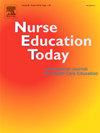以讲故事为基础的护生烧伤护理教育计划的开发与应用
IF 4.2
2区 医学
Q1 EDUCATION, SCIENTIFIC DISCIPLINES
引用次数: 0
摘要
在全球范围内,特别是在韩国等国家,针对护理学生的专门烧伤护理教育似乎有限。讲故事,被认为具有培养情感投入和提高记忆保留的潜力,是提高烧伤护理能力的一种有前途的方法。目的本研究发展并评估以故事为基础的烧伤护理教育计划(shep)在改善护生知识、态度、表现和自我效能方面的效果。设计采用混合方法设计,采用随机对照试验评估定量结果,采用焦点小组访谈(fgi)收集定性见解。该研究是在韩国首尔的一所护理学院进行的。60名大三、大四护生被随机分为实验组和对照组。实验组25名学生进行fgi。方法实验组参与一项SBEP,对照组使用所提供的材料完成独立研究。定量数据通过前后测试收集,定性数据通过fgi获得。结果实验组在知识方面有显著提高(w = 765, p <;0.001),性能(w = 879, p <;0.001),自我效能感(t = 3.73, p <;0.001),与对照组相比。fgi出现了三个主要主题:(1)通过激发思维加深对烧伤护理的理解;(2)加强实践技能;(3)通过情感参与提高学习质量。结论sep有效提高了护生烧伤护理能力。通过培养情感参与和将理论知识与实际应用联系起来,讲故事提供了一种有价值的方法来解决教育差距,并为未来的专业护士做好准备,以患者为中心的护理。本文章由计算机程序翻译,如有差异,请以英文原文为准。
Development and application of a storytelling-based burn care education program for nursing students
Background
Specialized burn care education for nursing students appears to be limited globally, especially in countries such as South Korea. Storytelling, recognized for its potential to foster emotional engagement and improve memory retention, presents a promising approach to enhancing burn care competencies.
Aim
This study developed and evaluated the effectiveness of a storytelling-based burn care education program (SBEP) in improving nursing students' knowledge, attitudes, performance, and self-efficacy.
Design
A mixed-methods design was employed, integrating a randomized controlled trial to assess quantitative outcomes and focus group interviews (FGIs) to gather qualitative insights.
Settings
The study was conducted in a nursing college in Seoul, South Korea.
Participants
Sixty junior and senior nursing students were randomly assigned to the experimental or control group. FGIs were conducted with 25 students from the experimental group.
Methods
The experimental group participated in an SBEP, while the control group completed an independent study with the provided materials. Quantitative data were collected using pre-and post-tests, and qualitative data were obtained from FGIs.
Results
The experimental group showed significant improvements in knowledge (w = 765, p < 0.001), performance (w = 879, p < 0.001), and self-efficacy (t = 3.73, p < 0.001) compared to the control group. Three overarching themes emerged from FGIs: (1) Deepening understanding of burn care through stimulated thinking, (2) strengthening practical skills, and (3) enhancing the quality of learning through emotional engagement.
Conclusions
The SBEP effectively improved nursing students' burn care competencies. By fostering emotional engagement and bridging theoretical knowledge with practical application, storytelling offers a valuable approach to addressing educational gaps and preparing future nurses for specialized, patient-centered care.
求助全文
通过发布文献求助,成功后即可免费获取论文全文。
去求助
来源期刊

Nurse Education Today
医学-护理
CiteScore
6.90
自引率
12.80%
发文量
349
审稿时长
58 days
期刊介绍:
Nurse Education Today is the leading international journal providing a forum for the publication of high quality original research, review and debate in the discussion of nursing, midwifery and interprofessional health care education, publishing papers which contribute to the advancement of educational theory and pedagogy that support the evidence-based practice for educationalists worldwide. The journal stimulates and values critical scholarly debate on issues that have strategic relevance for leaders of health care education.
The journal publishes the highest quality scholarly contributions reflecting the diversity of people, health and education systems worldwide, by publishing research that employs rigorous methodology as well as by publishing papers that highlight the theoretical underpinnings of education and systems globally. The journal will publish papers that show depth, rigour, originality and high standards of presentation, in particular, work that is original, analytical and constructively critical of both previous work and current initiatives.
Authors are invited to submit original research, systematic and scholarly reviews, and critical papers which will stimulate debate on research, policy, theory or philosophy of nursing and related health care education, and which will meet and develop the journal''s high academic and ethical standards.
 求助内容:
求助内容: 应助结果提醒方式:
应助结果提醒方式:


